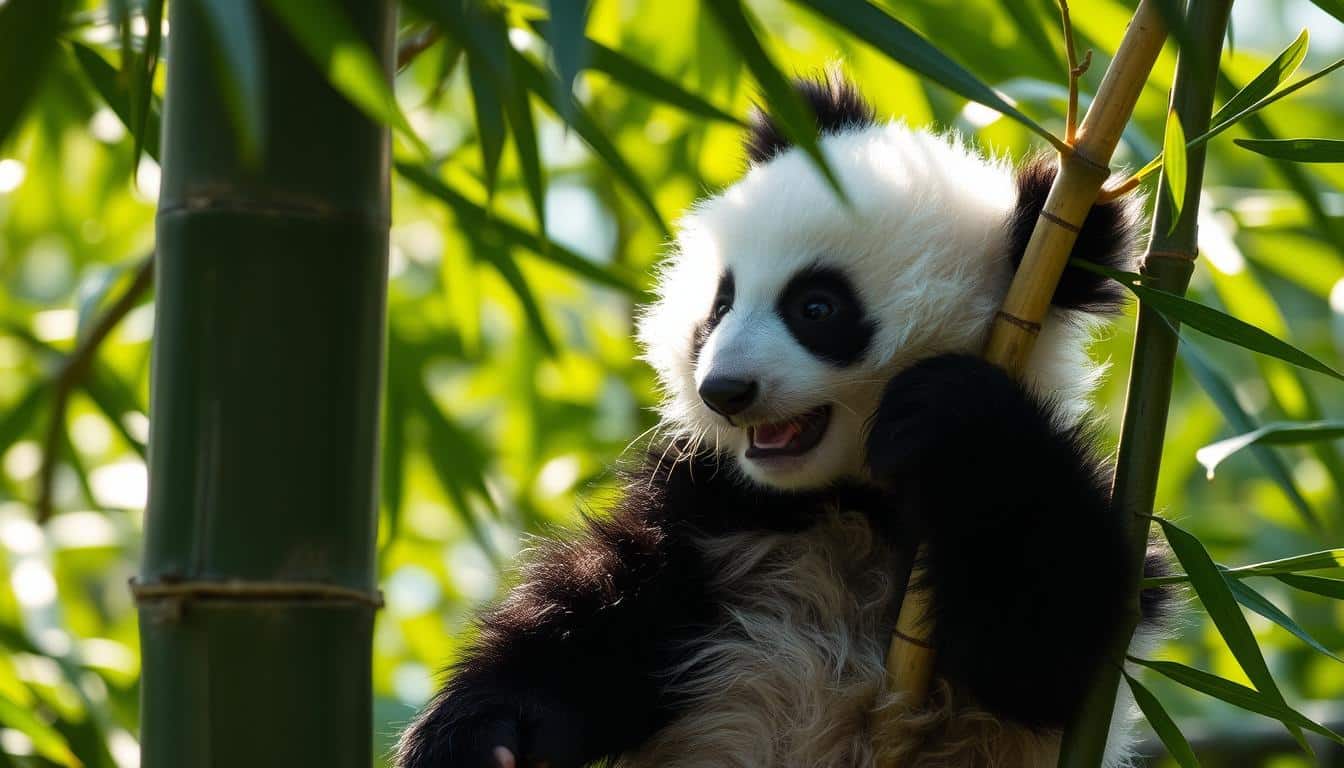Pandas are loved by people all over the world. Their fluffy, black-and-white fur and cute actions have inspired many photographers. Whether you’re experienced or just starting, capturing pandas can be very rewarding.
This guide will cover the basics of Panda Photography Techniques. We’ll talk about the best techniques, the right gear, and how to handle panda behavior and their homes. You’ll learn how to take amazing panda photos that will amaze everyone.
Key Takeaways
- Understand the unique challenges and best practices for panda photography, including equipment selection, camera settings, and capturing panda behavior.
- Discover the most popular panda photography destinations in China and how to plan your itinerary for the best possible experience.
- Learn about the ethical considerations and conservation efforts surrounding panda photography, and how to contribute to the protection of these remarkable creatures.
- Explore techniques for capturing captivating panda portraits, even in low-light conditions, to ensure your images truly showcase the beauty and personality of these gentle giants.
- Gain insider tips and insights from experienced panda photographers to elevate your photography skills and capture the perfect panda shots.
Introduction to Panda Photography
The giant panda has won the hearts of many photographers worldwide. These animals, known for their black-and-white coats and gentle nature, live in China’s Sichuan province. They offer a special chance for nature lovers and wildlife photographers to see their unique behaviors.
The Allure of Giant Pandas
Giant pandas are loved for their charm and their endangered status. With only a few thousand left in the wild, seeing them is a rare gift. Their beauty and gentle nature make them symbols of conservation, and photos can help protect their homes.
Why Photograph Pandas?
Photographing pandas shows their beauty and importance. It can also help conservation efforts. By capturing their unique behaviors and habitats, you share their story with the world. It’s a rewarding experience for wildlife photographers and nature lovers alike.
| Panda Statistics | Value |
|---|---|
| Captive Pandas in China (2007) | 239 |
| Captive Pandas outside China (2007) | 27 |
| Estimated Wild Panda Population (2006) | 2,000 – 3,000 |
| Average Lifespan in the Wild | 20 years |
| Average Lifespan in Captivity | 30 years |
| Oldest Captive Panda on Record | 34 years |
| Average Adult Male Weight | up to 160 kg (350 lb) |
| Average Adult Female Weight | 75 kg (170 lb) to 125 kg (280 lb) |
| Daily Bamboo Consumption | 9 to 14 kg (20 to 30 lb) |
“Photographing pandas in their natural habitat provides a unique opportunity to capture their behavior and interactions, offering a glimpse into their world.”
Preparing for Your Panda Photography Adventure
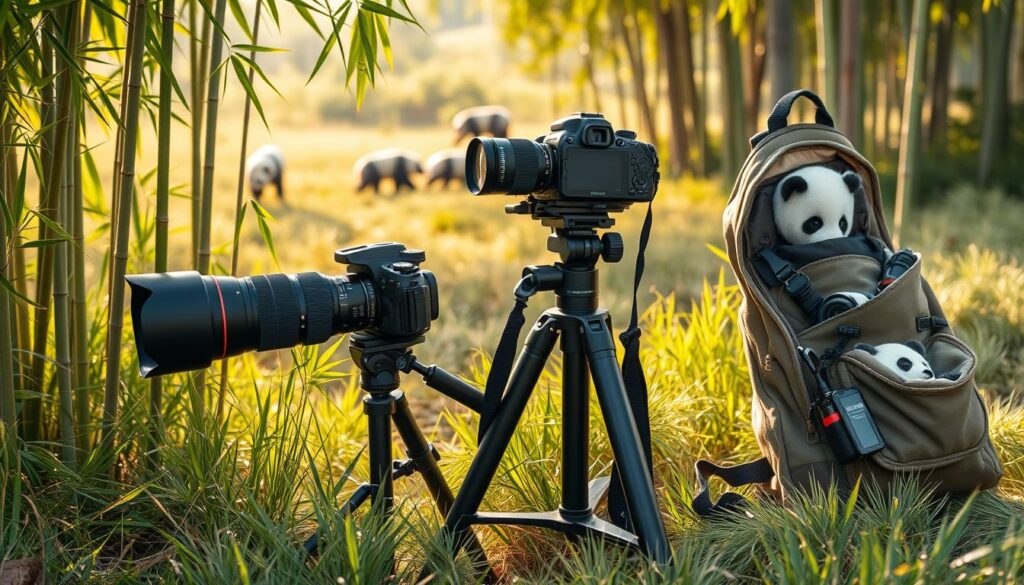
Start an amazing panda photography adventure by picking the right gear and planning your trip. A 70-200mm telephoto lens is key for getting close-up shots of giant pandas without disturbing them. Try to visit when they eat or are most active for the best photos.
Choosing the Right Gear
The right gear is essential for panda photography. A 70-200mm telephoto lens lets you take photos from a safe distance. It’s a must-have for anyone serious about capturing pandas’ special moments.
Planning Your Itinerary
Planning your panda photography trip is important for great photos. Visit during feeding times or when pandas are most active. Also, look for exclusive tours or access for unique photos.
With the right gear and a good plan, your panda photography adventure will be unforgettable. Whether you’re experienced or just starting, your trip to China’s panda habitats will be special.
Panda Photography Techniques
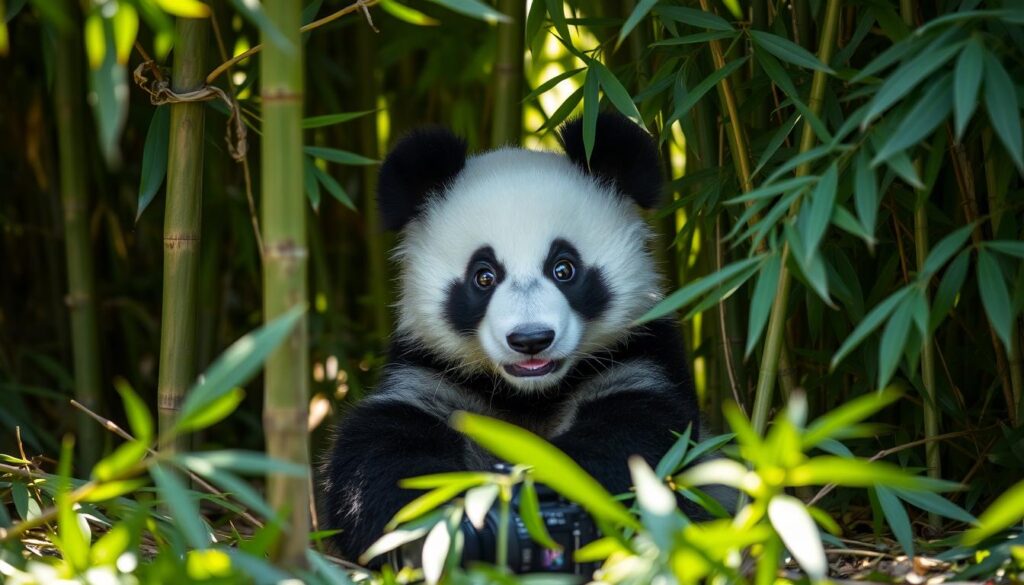
Capturing Panda Behavior
Photographing pandas can be very rewarding. You can capture their playful moments, how they eat, and how they rest. To do this, you need to be in the right spot and ready to take photos fast.
It’s important to be patient and keep trying. Pandas can be hard to predict. Knowing how they act and where they live helps you get the best photos.
- Observe panda behavior and anticipate their movements
- Use a fast shutter speed to freeze action
- Experiment with different angles and compositions
- Exercise patience and perseverance to capture the right moments
- Understand the pandas’ natural habitat and behavior
A study in Scientific Reports showed how pandas blend in. Their black and white fur helps them hide in the forest. This makes them hard to spot.
To take great photos of pandas, you need skill and patience. Knowing how they act and where they live is key. With these tips, you can take amazing photos that everyone will love.
Exploring Panda Habitats

Photographing pandas in their natural habitats can create amazing images. The bamboo forests and sanctuaries of Sichuan, China, are perfect for this. Knowing the local landscape and lighting helps you plan your shots.
Giant pandas have fur that blends well with their surroundings. Their black and white fur helps them hide in the trees and on the ground. This makes it easier to capture their natural movements.
It’s important to respect pandas and their habitats. Getting too close can be dangerous for both you and the pandas. China has made great efforts to protect pandas, offering places for photographers to learn and see them.
| Panda Habitat Statistics | Value |
|---|---|
| Number of wild pandas | 1,864 |
| Number of pandas in zoos and breeding centers | 600 |
| Percentage of habitat considered habitable for optimal gene flow | 80% |
| Panda breeding season duration | 24 to 72 hours |
Exploring panda habitats is a rewarding experience for photographers. By understanding their natural behaviors and the environment, you can take stunning photos. These photos show the beauty and importance of pandas in their ecosystems.
Ethical Considerations in Panda Photography
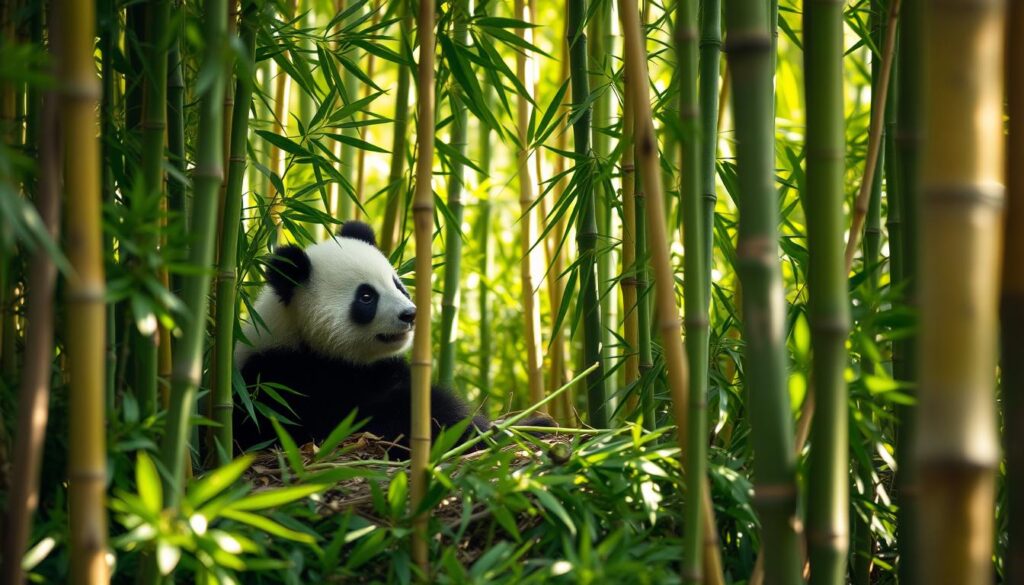
As panda photographers, we must care for these amazing animals. Pandas are not just subjects; they are living beings that deserve our respect.
Respecting the Animals’ Well-being
When taking pictures of pandas, keep a safe distance. Avoid actions that might stress them. Don’t get too close or enter their space, as it can harm them.
Instead, watch and snap from afar. Use telephoto lenses or zoom to get close without being intrusive. This way, you can capture their unique expressions and behaviors.
Promoting Conservation Efforts
Your photos can help spread the word and support conservation. Share your images and stories to teach others about pandas and their plight. Work with groups like the Chengdu Research Base of Giant Panda Breeding to ensure your work helps protect pandas.
Ethical panda photography means more than just great shots. It’s about respecting their natural habitat and behavior. It’s about using your love for photography to help save these incredible animals.
“Panda photography is a privilege, not a right. Let’s use our cameras to raise awareness and inspire action for their protection.”
Low-Light Panda Photography
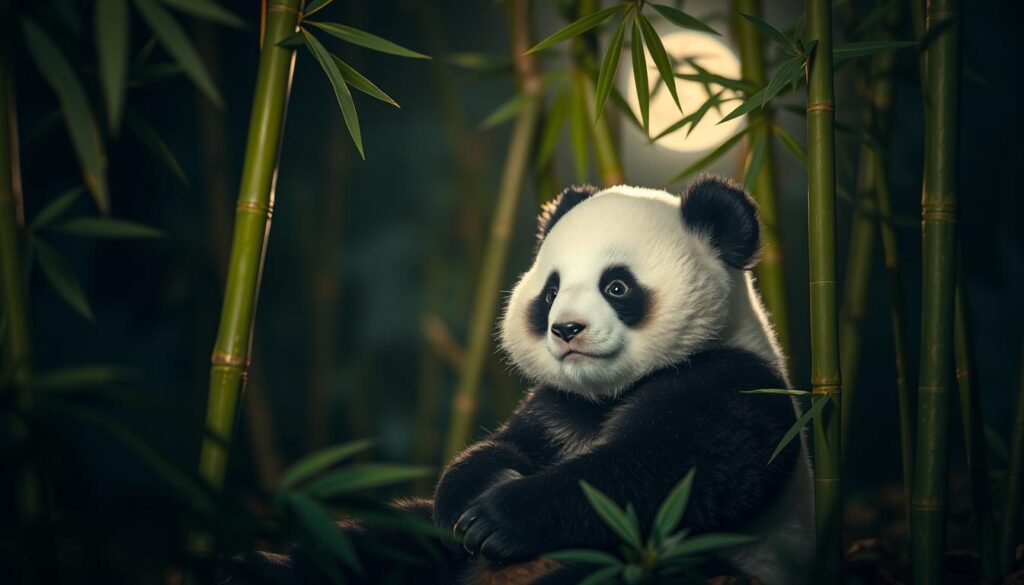
Capturing giant pandas in low light is a fun challenge for photographers. You might shoot in indoor enclosures or during early morning and evening. Adjusting your camera and using smart techniques can lead to clear, sharp images.
Camera Settings for Low-Light Conditions
To do well in low-light panda photography, adjust your camera settings. Raise your ISO to 1600 or 3200 to catch more light. Use a wider aperture, like f/2.8 or f/4, to let in more light. Also, set a faster shutter speed, like 1/250 or 1/500, to stop motion and avoid blur.
Techniques for Sharp and Noise-Free Images
There are more ways to get clear panda photos. Use image stabilization to reduce camera shake. Frame your shots carefully to avoid distractions. Also, position yourself to use the light well, whether it’s natural or artificial.
| Camera Setting | Recommendation |
|---|---|
| ISO | 1600 to 3200 |
| Aperture | f/2.8 to f/4 |
| Shutter Speed | 1/250 to 1/500 second |
Mastering low-light panda photography lets you capture amazing images. These images show the pandas’ behavior and unique personalities, even in tough light. With the right settings and techniques, you can get clear, high-quality photos that impress everyone.
Panda Photography Techniques
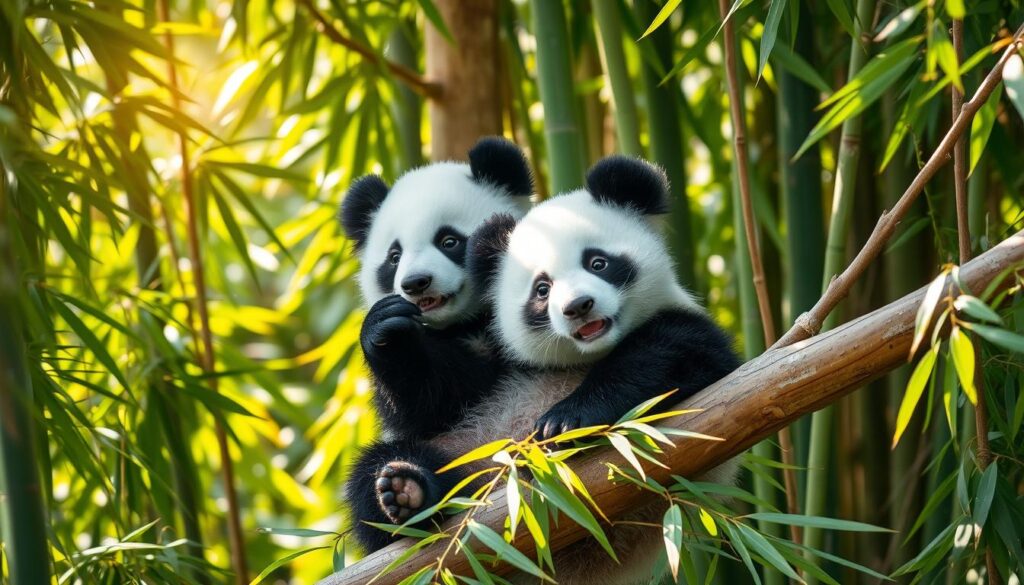
Capturing pandas through photography needs a deep understanding of their behavior and habitat. It also requires mastering low-light photography. The art of panda photography is both nuanced and rewarding, appealing to photographers of all levels.
Understanding pandas’ natural behaviors is key. Pandas are solitary and often sleep a lot, so planning and patience are essential. By observing their movements, you can capture perfect shots, like a playful cub or a serene adult panda eating bamboo.
Proper camera settings are crucial for panda photography. Fast shutter speeds freeze action and capture moments of panda activity. Adjusting ISO for low light, like in bamboo forests, ensures sharp images. Try different focal lengths to capture pandas in all their glory, from close-ups to wide shots.
When photographing pandas, ethics are paramount. It’s important to respect their well-being, keep a safe distance, and not disrupt their natural behaviors. This ensures your photos help in conserving and appreciating these amazing animals.
Whether you’re an experienced wildlife photographer or just love pandas, mastering panda photography is rewarding. By using the right techniques and respecting these animals, you can create stunning images. These images will inspire others to appreciate the giant panda’s beauty and importance.
“The giant panda’s unique coloration is a remarkable example of natural camouflage, allowing them to blend seamlessly into their bamboo-filled habitat.” – Dr. Ossi Nokelainen, lead researcher
Also Read : Panda Trekking: Adventure In China’s Bamboo Forests
Conclusion
Panda photography is a special and fulfilling journey for all photographers. It lets you capture the beauty of pandas and their homes. It’s important to care for the animals and use your photos to help protect them.
With patience and a love for these amazing beings, you can make photos that touch hearts. These photos can help people understand why we must save pandas. Whether in China or Sichuan, seeing pandas in their natural setting is unforgettable.
Learning to take great panda photos helps you create beautiful wildlife images. It also helps in the fight to save these incredible creatures and their homes. This guide will help you show the world the beauty and importance of pandas.
FAQs
Q: What are some essential photography tips for capturing pandas at a zoo?
A: When photographing pandas at a zoo, it’s crucial to use photography tips such as minimizing noise and using a fast shutter speed to capture their movements. Make sure to arrive early to avoid crowds and utilize the best options for angles around the enclosure.
Q: How can I effectively photograph a red panda at the Chengdu Research Base of Giant Panda?
A: To effectively photograph a red panda at the Chengdu Research Base of Giant Panda, consider going early in the day when the animals are most active. Use a telephoto lens to capture close-up shots without the barrier of the fence and arrange your shots to highlight their playful nature.
Q: What is the best time to visit the Chengdu Panda Center for photography?
A: The best time to visit the Chengdu Panda Center for photography is early in the morning, as the pandas are typically more active and the lighting is ideal for nature photography. Additionally, this helps avoid the larger crowds of visitors.
Q: Are there specific zones at the panda center that are better for wildlife photography?
A: Yes, the Chengdu Panda Center has specific zones where visitors can have a clear view of the pandas without obstructions. Make sure to explore these areas and choose spots that allow you to take pictures from different angles, enhancing your wildlife photography experience.
Q: What equipment do I need to capture the best panda photos?
A: For capturing the best panda photos, an experienced photographer recommends using a DSLR or mirrorless camera with a telephoto lens. This allows you to photograph pandas without getting too close to the cage or fence, ensuring a unique experience.
Q: How can I minimize distractions while photographing pandas?
A: To minimize distractions while photographing pandas, try to go during off-peak hours when there are fewer visitors. Additionally, keep your noise levels down to avoid startling the animals, which could affect your photo opportunities.
Q: What should I consider when taking photos of baby pandas?
A: When photographing baby pandas, consider using a fast shutter speed to freeze their playful movements. Arranging your shots to capture their expressions and interactions with their environment can highlight their cuteness and make for memorable images.
Q: Can I photograph pandas at the Chengdu Panda Center during a guided tour?
A: Yes, you can photograph pandas during a guided tour at the Chengdu Panda Center. However, it’s essential to follow the guidelines provided by your guide to ensure the safety of the animals and the best opportunities for photography.
Q: Is it a good idea to photograph pandas during the feeding times?
A: Yes, photographing pandas during feeding times can be a good idea as they are often very active and engaging. This is a time when you can capture unique moments of their behavior that highlight their interactions with food.
Source Links
- https://www.epicbyerika.com/post/photographing-the-giant-pandas-in-china
- https://www.smithsonianmag.com/science-nature/why-photographing-pandas-more-challenging-you-might-think-180969108/
- https://www.kiwifoto.com/galleries/mammals/giant_panda/
- https://www.boredpanda.com/guide-to-photography-composition-barry-o-carroll/
- https://birdwithabrush.com/2022/12/18/reference-realism-and-red-pandamonium/
- https://www.nathab.com/asia-adventure-travel/wild-china-panda-photo-expedition/

